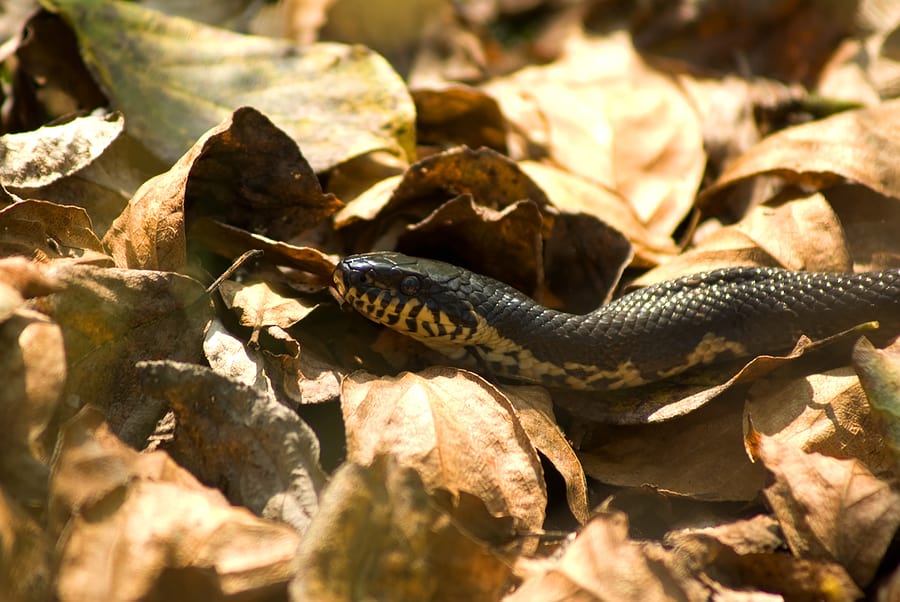Snakes are actually more active in the fall than any other season of the year. In the United States, most snakes are born between July and September. These baby snakes will be actively looking for their first meals in the fall, making them much more likely to be seen. By springtime, however, many of these young snakes will have been eaten by predators or run over by cars. Many snakes are also active in the fall as they are moving around in search of somewhere to hibernate or brumate over the winter months. There are even some types of snakes (like the canebrake rattlesnake) that mate in the fall, making them much more active as they go in search of a mate.
Snake activity picks up as the temperatures start to fall in late summer and early fall. Snakes cannot thrive when temperatures drop below 65 degrees Fahrenheit. With the weather still ideal and an abundance of rain from late summer storms and hurricanes, fall is prime time for snakes to be active. Falling leaves in the fall also provide ideal camouflage for snakes.
Snakes will go into hiding as early as September or as late as December depending on which part of the country you live in. Depending on where they are, snakes will either hibernate or brumate. Hibernation occurs when snakes enter a deep sleep state, usually in colder snowy climates. In brumation, snakes don’t actually sleep; instead their bodies acclimate to the lower temperatures, their metabolism slows down, and they become less active and less likely to feed. Brumating snakes may wake up and come out to bask in the sun on warmer days even in the middle of winter.
Just like snakes, many people become more active in the fall, as well, taking advantage of the cooler temperatures to enjoy time outdoors. If you spend time outdoors in the fall, keep these snake prevention tips in mind.
- Cover Up. If you choose to spend time outdoors, make sure to wear closed-toe shoes and long pants if possible. Try to avoid sandals and flip flops as they leave your feet and toes exposed to potential snakebites.
- Avoid Habitats. Snakes like to hide in areas that provide them protection and coverage from predators. They can often be found in tall grass, overgrowth, on or under large rocks, rock piles, and wood piles. If you have to walk through these areas, keep your feet and legs protected, keep your eyes pealed, and make your presence known.
- Familiarize Yourself. Identifying snakes is critical to avoiding and preventing them. Do some research and find out which snakes are common in your area, what they look like, and where to find them. Identify any areas you spend time in outdoors that could potentially house snakes and try to avoid them.
- Keep an Eye on the Sky. Some types of snakes can actually climb trees and will even use overlapping branches to move from tree to tree without ever touching the ground. When walking or boating through wooded areas make sure to look up and keep an eye out for overhead snakes.
- Have Confidence. Snakes don’t have ears so they can’t actually hear you coming but they do respond to vibrations in the ground and can feel you coming before they actually see you. When walking outdoors walk with strong, confident steps and make your presence known.
- Be Aware. This one goes without saying but be aware of your surrounding when spending time outdoors. Look down when walking and check overhead when in wooded areas. Try to identify snakes before you walk right up on them.
- Check Your Car. Snakes will use anything to hide from predators, especially if it has a warm surface, including your car. Check under your hood before cranking your car, especially first thing in the morning or if you park in an area that is prone to snakes.
- Clean Up Your Home. Making your home and yard less inviting to snakes will help keep them from coming in. Seal any cracks and crevices on the outside of your home to keep snakes out in search of warmth and food. Remove any debris and clutter from your yard and garage. Keep woodpiles elevated and stored away from your home. Clear any overgrowth from your yard.
- Use snake repellent. There are many commercial snake repellent products on the market today. If you prefer a more green snake control option, there are also natural snake repellents you can make at home. Choose whichever option works best for you.
As the weather cools and we move into fall, snakes will be on the move! If you have a problem with snakes or any other wildlife in and around your home, contact a professional pest control company who can help identify the source of the problem and help with an elimination and prevention plan.
You May Also Be Interested In:
Palmetto Bugs and Cockroaches: Are They the Same?
10 Effective DIY Pest Control Tips for Homeowners
Stink Bugs: What Do They Actually Do?

